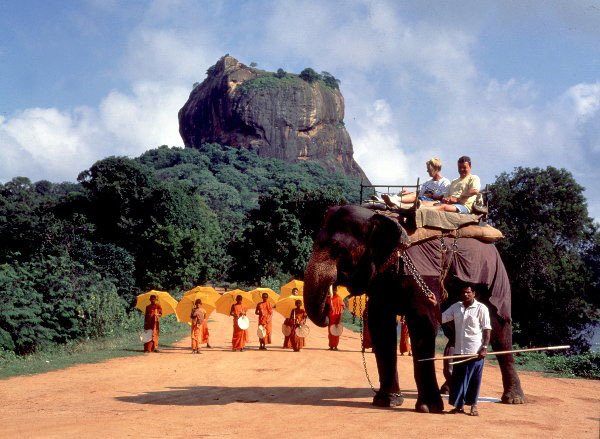Where am I : India Tour Packages » Most Popular Packages » Sinharaja Tour Packages
Visit in Sinharaja
Sri Lanka, this island state located in the southeast of India, contains incredible biodiversity due to the diversity of the natural environments it shelters, such as the Sinharaja reserve. Its specific geographical location on a geological fault and its humid tropical climate make it an ideal environment for many endemic species, such as the Sri Lankan elephant evolving in the heart of a verdant and luxuriant flora.
Sri Lanka is one of the most beautiful islands in the Orient. With its glorious history, rich culture, and natural beauty, Sri Lanka attracts many local and international tourists annually. Since the country's different regions have different climatic conditions and it is home to a variety of endemic flora and fauna, there is much to enjoy and marvel at in the country. Sinharaja Forest Reserve, one of the pearls of Sri Lanka, is located in the southwest of the island and is the remains of a virgin tropical rainforest. This forest is the last refuge for rare animals like wild boars, muntjacs, giant squirrels, civets, porcupines, mongooses, purple-faced white-bearded thin-bodied leopards, and highly wary leopards. This forest is precious only because many plant species not found elsewhere grow in it, which is why Sinharaja was declared a World Heritage Site. Also, the cultural heritage of various ethnic groups in Sri Lanka makes for a truly unique experience. These are some of the best places to visit in Sinharaja, Sri Lanka.
About the Sinharaja Forest Reserve
The Sinharaja Forest Reserve is one of the few tropical rainforests. This array of flora and fauna is diverse and unique, which was why the Sinharaja Forest was declared a Biosphere Reserve in 1978, and recognized by UNESCO as part of its international network of biosphere reserves in 1988 and a World Heritage Site in 1989. The Sinharaja Rainforest is the oldest ecosystem and treasure on the earth.
One of the protected natural reserves of Sri Lanka, with an extension of more than 8 thousand hectares, in this space, you will find an enormous amount of fauna and flora that are native to the area and are not seen anywhere else in the world. The tours to the Sinharaja Forest Reserve take you through part of the jungle and its rivers and bathe in its waterfalls. Guided tours of the Sinharaja Forest Reserve show why it was declared a cultural heritage site in 1988. At the same time, the friendly treatment and the tranquility of the area make the trip a place to connect with nature. On an excursion to the Sinharaja Forest Reserve or also called the kingdom of the lion, the guides will be at the entrance of the reserve, and after paying your entrance, they will take you on your tour of the jungle; it is recommended to wear comfortable shoes because walking and contemplating the wonders nature is part of the itinerary. Sinharaja Forest Reserve is located in the humid zone south of Sri Lanka. The Sinharaja Game Reserve occupies less than 0.2% of the island and extends over just over 11,000 hectares of land, at an altitude of 150 to 1171 meters above sea level. The territory consists of successive ridges and valleys. The dense forest provides a habitat for various birds, including the Sri Lankan azure magpie, great racket-tailed drongo, white-headed starling, orange-bellied shrub, bush cuckoo, and the extremely rare green-billed cuckoo. Among other creatures, the Ceylon cottonmouth, the green rattlesnake, and various amphibians, including tree frogs, enjoy living in the green wilderness. Many insects live here, including the ornithopter butterfly, which is nowhere else found.
Features of the Sinharaja
The name of the rainforest translates as "lion-king" or "lion kingdom," which is not surprising. The main population of Sri Lanka - the Sinhalese - consider themselves descendants of lion people, and the image of the legendary king of beasts flaunts on the flag and emblem of the state. The local population perceives the natural treasure as the highest gift, which must be treated with respect and awe.
The Sinharaja is a real treasure trove that keeps a beautiful world, hiding many natural treasures untouched by man. The territory of Sinharaja is conditionally divided into two sections. One is characterized by lush vegetation; the other is deprived of its original cover due to the passage of lava that escaped from the earth's bowels during one of the earthquakes. There are mountain peaks within the boundaries of the park. The highest is Hinitipigala (1170 m); the most popular is Maulavela (760 m). From their peaks, stunning views of the surrounding nature open up.
Inhabitants of the Sinharaja reserve
Several rare animals live on the reserve's territory, found in natural conditions only within the boundaries of a particular natural zone of Sri Lanka. The endemism of mammals and butterflies here is more than 50 percent, and birds - 95 percent. 19 out of 20 birds are unique since they do not exist anywhere else on the planet. In addition, more than 60 percent of forest vegetation is endemic. Of the 217 species of trees and woody vines, 139 are considered exclusively from this area, 16 of which are rare.
Sinharaja reserve dweller
Several rainforest inhabitants belong to the endangered species of the animal world, which are threatened by extinction. These include:
- leopards;
- Indian elephants;
- purple langurs;
- Sri Lankan tree pigeons;
- green spur cuckoos;
- white-eyed starlings;
- ash-headed boobies;
- Purple broads.
In the forest, you can meet deer and pythons, giant squirrels and martens, mongooses and monkeys, armadillos and other representatives of mammals, birds, fish, amphibians, and butterflies.
The rich flora of the nature reserve is represented by deciduous trees, lianas, palms, unique flowering plants, shrubs, medicinal herbs, etc.
Sinharaja and its scientific interest
It represents the last remnant of the tropical rainforest in Sri Lanka. As such, its flora is essential for scientific knowledge about continental drift. Its great site also makes it possible to study the processes of biological evolution. Indeed, the basement of Sinharaja has fascinating geological characteristics. The Sinharaja forest reserve, by its large size, ensures the conservation of rare and endangered species and actively participates in the biological evolution for which it is registered. This site is bordered by 13 natural forest areas, giving it additional protection. However, it would be desirable for its limits to be better defined. The agency in charge of managing this property tries to improve the conservation status of the reserve by legislating the use of the neighboring territories. Indeed, illegal logging, poaching and searching for precious stones negatively impact the reserve's integrity.
Rain forest visit
The duration of the walk-in in Sinharaja is calculated from 2 to 8 hours. How interesting you can see during this time depends on the group's activity and the guide's qualifications. Not all guides have the desire to lead tourists along hard-to-reach and unique trails. Most prefer to take less impressive routes. According to travelers, a small additional fee helps inspire the accompanying person. Tourists are offered several hiking trails. In addition, you can take advantage of the offer to overcome part of the way by jeep. Such a service is paid separately. It is allowed to stay in reserve only in the presence of local guides.
Reasons why you should visit Sinharaja Forest
Sinharaja Forest is the last viable area of ??tropical rainforest in the country. More than 60% of its trees are rare and unique to Sri Lanka. The fauna, also endemic, is diverse. It includes many birds, butterflies, mammals, insects, and reptiles. This mountainous reserve has survived commercial exploitation thanks to its inaccessibility.
Spoiled by nature
Among the forests of Sri Lanka, it is undoubtedly the most magnificent. Take a simple walk in Sinharaja, and you will be immediately amazed. The striking flora cabinet is the country's most famous and prosperous vegetation! The fabulous characteristics of Sinharaja result from exceptional natural advantages. Dependent on important hydrography, it has many valleys. The micro flora present in the soil is very suitable for the proliferation of plant species. It is, therefore, not a surprise to see this site listed as a UNESCO World Heritage Site.
Adam's Peak
Adam's Peak, also known as the Butterfly Mountain or Sri Pada, is a mountain that is considered sacred by all people in Sri Lanka, regardless of religion. Buddhists believe that this bears the imprint of Lord Buddha. Hindus believe it is from God Shiva and Islamic people, and Christians believe it is Adam's footprint. Studying Sri Lankan neocolonialism claim that these beliefs result from Sri Lankan colonial knowledge production. The mountain is surrounded by forests that are home to many animals. Pilgrims start climbing the mountain at night to reach the top at dawn. The season is usually the month of April when large groups of pilgrims from many religions climb the mountain.
Its flora is extraordinary.
Why do you think we go to a forest? Isn't it to see plants, among other things? The main wealth of this forest is its superb vegetation. Incredibly lush, it will charm you every time. If Sinharaja were a football team, his shirt would be green. You will be full of admiration for its fantastic canopy. Here you will be privileged. You will see 16 rare endemic species such as calamus, Caryota, and shorea. It's almost a record. For those who have already been to West Africa, you will see the famous oil palm among the 830 species of the forest. It is a much sought-after priceless wealth that will be at your fingertips.
Mysterious forest of Sinharaja
Walking through the rainforest requires at least minimal physical fitness and the availability of appropriate equipment. Shoes should be as closed as possible, with anti-slip soles, and clothing should have long sleeves and legs. Be sure to bring a light hat and wear socks. At checkpoints, they offer to rent high shoe covers. Forest insects and leeches do not disregard open areas of the body. The bites of some of them can be extremely dangerous. For example, leeches secrete substances that reduce blood clotting. Stopping it without medical intervention can be pretty tricky. Care must be taken during the journey, and after it is over, carefully examines the clothes.
An adorable fauna
Similar to a humanitarian center, the luminous vegetation of Sinharaja welcomes a slew of animals. The dense forest can easily scare off an unsuspecting visitor. But your ability to read between the lines will allow you to discover a magical spectacle! You will attend an exceptional zoological opening. Imperial leopards will be visible, which are usually undisturbed by footsteps and the crackle of cameras. However, don't be overwhelmed by the swells of admiration. They are still wild animals! In the sky, it's a constant ballet of contingents of birds that will keep you spellbound. Reptiles, butterflies, and amphibians will also be there.
A magnificent site of botanical conservation
The encroachment of man on the territory of biodiversity has caused many problems. Countless species are now threatened. Science, therefore, needs a truly protected space to allow the recovery of populations of endangered plants. The Sinharaja reserve is the place to achieve these ends. So we can do experimentation and conservation. It is much protected and therefore very favorable. Many laws are taken to make this reserve more of an actual fort. Deterrent patrols roam Sinharaja, which is mainly prey to logging.
Trekking
An immersion that you will not soon forget. You will be in contact with many gems made available to you by nature! There are two villages west of the reserve: Parankandeniya and Kolomthota. You can take a tour there. This will be an opportunity to see new lifestyles while remaining in contact with biodiversity. The sharing of culture that you will attend will surely enlighten you!
Weather in Sinharaja Reserve
The annual precipitation range of Sinharaja ranges. Most precipitation falls from the southwest monsoons in May-July and the northeast monsoons in November-January. February is considered a dry month, but there can be heavy showers even during the dry months. The Sinharaja Wildlife Sanctuary can be visited any time, but the best trekking is from December to April. It is helpful to have a raincoat with you. Fog is a common sight in the Sinharaja rainforest. Fog occurs due to the proximity of the ocean, high humidity levels close to 100%, and temperature differences. The water evaporates and rises in the form of steam above the forest until it reaches a height at such a temperature that the vapor particles combine to form droplets, forming a dense fog. When the drops become heavy, they fall back into the forest as rain and evaporate again, forming a continuous water cycle.
When to go there?
Sri Lankan land temperatures vary relatively little throughout the year. They generally and, on average, oscillate between 28 and 30 degrees. Humidity and precipitation are two exciting data to study before leaving. The ideal is to visit the Sinharaja reserve in January, February, or March. It rains very little during this period, taking walks in the tropical forests is more pleasant. However, you can decide to forget comfort, focus on natural optimization, and de facto avoid mass tourism. The months of October and November are the wettest in the country, the rain is legion, but you will hardly see anyone, which will perhaps push the animal species to show the tip of their noses more.
How to get to the Sinharaja
You can get into the national park from the north and south. In the first case, the nearest settlement is Kalavana, and in the second, Deniyaya. The best way to get from Ratnapura is via Rakwana.
Bandaranaike International Airport is located in the largest city of Sri Lanka - Colombo. Many villages can be reached from here by bus. There is a railway connection with settlements located in the southwestern part of the island.
Tips before going to the Sinharaja Rainforest
What to wear:
- shorts or light trousers that can be tucked into socks to provide "tightness";
- T-shirt or light shirt with short/long sleeves;
- Long socks;
- Hiking shoes;
- Women should collect or stab long hair;
- Cap.
What to take with you:
- Small light backpack;
- Photo, video camera;
- Binoculars;
- Rain jacket;
- Slates and bathing suit for swimming in the natural pools of waterfalls;
- A bottle of water;
- Snack products, energy bars;
- Plastic bag (to protect the camera);
- Handkerchief;
- Personal hygiene items;
- A little salt, soap, and repellent (to protect against leeches);
- Lighter;
- Sunglasses;
- Protective cream.
Conclusion
You can enter the reserve from three entrances, although the most common access is from the Deniyaya area, a small town on the edge of the tropical forest. During the walk, the guide will lead you through the lush vegetation of Sinharaja, with many explanations about the importance of this rainforest to the Sri Lankan ecosystem. In addition, depending on the visit chosen, it is possible to swim in one of the freshwater lakes in the middle of the jungle. Being a particular conservation area, visits are made exclusively in Sinharaja; one more reason to stop on your route through the south of Sri Lanka and marvel at this green and magical back room. Are you ready to visit in Sinharaja during your trip to Sri Lanka?
Speak to our Experts!
Instant Quote, Best Deals - 100% Customizable, Includes hotels + car + guides Cost depends on various factors like, number of people you are, travel dates, category of hotel and transportation etc.Drop your Inquiry to get the best deals as per your requirements. 100% Satisfaction Guaranteed. Rated 5* in TripAdvisor.Loading...





